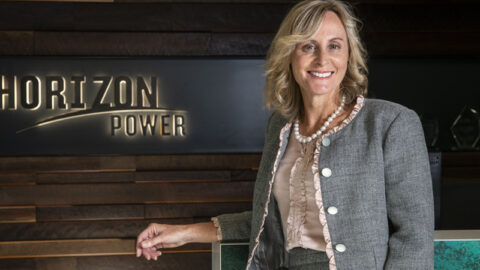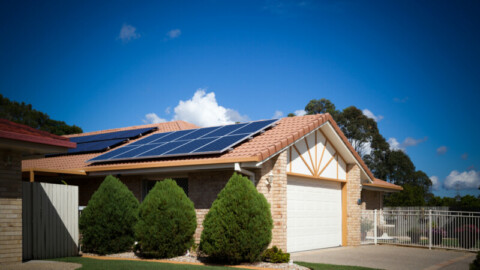by Ian Learmonth, Chief Executive Officer, Clean Energy Finance Corporation (CEFC)
As international efforts ramp up to meet commitments of the Paris Accord, Australia is driving towards a low emissions future that delivers reliable, environmentally responsible, affordable energy.
But there’s a challenging road ahead which will require long-term commitment and investment in technologies that can deliver reliable, affordable, low carbon electricity as we shift from a grid that is based around centralised baseload and peaking generation to a smart grid with increased supplies of renewable energy and distributed energy resources.
The Clean Energy Finance Corporation (CEFC), which was established by the Australian Government in late 2012, has made cumulative investment commitments of more than AU$5.8 billion to projects with a total value of more than AU$16 billion.
These investments make us Australia’s largest debt financier for grid-scale solar PV, and the largest single investor in Australia’s clean energy venture capital market through our Clean Energy Innovation Fund.
Through our investments, we have built a substantial, diverse portfolio of renewable, low emissions and energy efficient technologies that are supporting decarbonisation pathways across the breadth of the Australian economy. Our investments to date are estimated to help achieve emissions reduction of more than 180 million tonnes of CO₂e over the life of their associated projects.
At the CEFC, we have made a conscious effort to invest in the application of technologies that have yet to reach their full potential in Australia. As providers of both debt and equity, we’ve also used innovative financing models and have been prepared to take a view on merchant power prices in financing a renewables market often short of offtake contracting.
At the same time, we’ve looked to encourage third party financiers to invest alongside the CEFC in our transactions. Leveraging our own capital builds confidence in the markets and facilitates increased flows of finance into the clean energy sector.
In the context of the decarbonisation challenge, the CEFC invests across all industry sectors of the Australian economy, focusing on decarbonisation pathways of low carbon electricity, ambitious energy efficiency, and electrification and fuel switching, as well as reducing non-energy emissions.
Storage gearing up
As we’ve already seen with the operation of the Tesla battery at Hornsdale Power Reserve in South Australia, large-scale battery storage has the potential to flex from charge to discharge in an instant, making it both a valuable tool to harness supply peaks produced through the variability of large-scale solar and wind generation, and a game changer for immediate responsiveness to peaks in energy demand and grid volatility.
There’s a growing case for cost competitiveness when battery storage is linked to large-scale renewable generators. Bloomberg New Energy Finance (BNEF) released data in late March 2018 that puts the average combined cost of onshore wind and solar PV plants paired with small batteries at between US$32 and US$110 per MWh.
This compares with a global figure for coal and combined-cycle gas (CCGT) plants providing fully dispatchable generation at US$40 to US$146 per MWh. BNEF says that while standalone batteries are competitive today for hitting narrow peaks, they are expected to be able to cover wider and wider peak periods as their costs decline.
But for now, rolling out lithium-ion battery storage at a much larger scale is still cost prohibitive. That’s where pumped hydro, with its long project life and large energy capacity, steps up.
Researchers at ANU have identified 22,000 sites around Australia suitable for pumped freshwater hydro energy storage and the Australian Renewable Energy Agency (ARENA) has been working on a number of feasibility studies for projects in Tasmania, South Australia’s Spencer Gulf and the expansion of the Snowy Hydro scheme in Snowy 2.0. Each site has storage potential ranging from one to 300 gigawatt hours.
Accelerating change
As an accelerator of change, we’ve witnessed and supported the first significant shifts towards the increased inclusion of battery and storage technologies in both large and small-scale clean energy investment.
We’ve created new opportunities for grid-scale energy storage and investment in transmission that will be important for the reliability of our electricity system in the years ahead. Our own finance is working to further lower costs with our projects building experience across the construction and operation of large-scale clean energy generation and integrated storage solutions.
Our transactions demonstrating the benefits of batteries and storage include:
A winning solar, wind and storage trifecta
The CEFC has committed AU$94 million towards Windlab and Erus Energy’s Kennedy Energy Park which will be Australia’s first fully integrated wind, solar and battery project. The natural benefits of the Kennedy Energy Park site in central north Queensland will deliver high levels of solar energy throughout the day and strong wind generation in the evenings, creating a reliable generation profile around the clock, while the addition of a 2MW battery will provide more predictable, reliable and low-cost electricity.
When operational, the Kennedy Energy Park will be capable of generating enough power for more than 30,000 average homes. The project will demonstrate the value of matching wind and solar generation to provide more predictable, reliable and low cost renewable energy. The addition of the battery component will provide even greater value to the grid.
A golden transformation
Our AU$54 million investment with Genex Power assisted the development of Phase One of its Kidston Renewable Energy Hub, 270km north-west of Townsville — the construction of a 50MW solar farm, which is already generating energy and earning revenue from sales into the National Energy Market and through the sale of Large-scale Generation Certificates.
The solar farm is co-located with the proposed second phase of the project which will involve harnessing two large dams at the former Kidston Gold Mine site to develop a 250MW pumped hydro storage facility that will support around 1,500MWh of continuous power in a single six-hour generation cycle.
When built, this will be the first of its kind in Australia to co-locate a large-scale solar farm with a large-scale pumped hydro storage project, creating a combined generation and storage model for future projects.
An energy storage milestone
The CEFC has also committed AU$150 million in debt finance to stage one of the Lincoln Gap Wind Farm in South Australia’s Port Augusta region.
The project includes a 10MW battery energy storage system, capable of producing up to 10MWh of fast response storage capacity. It’s Australia’s first unsubsidised large-scale grid connected battery alongside a greenfield wind development.
The next generation of solar farms
In the past year, the CEFC has witnessed a shift towards large-scale solar developers designing projects to incorporate technologies that will enhance their ability
to supply energy seamlessly into the grid.
Sponsors are considering forecasting technologies and building projects that are “battery ready” so that storage can be easily added once the business case becomes suitably compelling.
Building the Australian battery storage supply chain
The CEFC’s US$15 million (about AU$20 million) cornerstone investment in a bond is helping finance the development of Pilbara Minerals’ Pilgangoora lithium-tantalum project in Western Australia which will produce lithia raw materials that can be used to support a full range of lithium products for lithium-ion batteries and energy storage solutions.
The learnings gained through the development of these projects will provide support to the battery storage supply chain, build local construction expertise, help optimise revenue models and provide a strong knowledge foundation for future projects seeking storage technologies to overcome intermittency issues.
Harnessing flexible capacity and increased storage capacity will help us build a stronger, secure electricity supply at the same time as enabling the increase of penetration of renewable energy generation to help us reduce our electricity sector carbon emissions.
But large-scale projects are just part of the Australian battery storage story. Analysts are anticipating a shift towards increased levels of distributed energy resources (DER) over the coming decades, as customers embrace new technologies to take control of their energy costs and contribute to the decarbonisation challenge.
Changing gear
Research by the CSIRO and Energy Networks Australia to develop The Electricity Network Transformation Roadmap, predicts that by 2027 more than 40 per cent of electricity system customers will use on-site DER consisting of 29GW solar and 34GWh of batteries.
At the CEFC, we’re investing in projects that further prove up the effectiveness of distributed energy technologies to help reduce energy costs for both householders and business.
We’re working towards inspiring a “new normal” of new residential developments with built in batteries and solar, a greater adoption of innovative smart technologies that reduce grid energy consumption for businesses and an increased uptake of electric vehicles.
For example:
GreenSync, a highly innovative clean technology company, is using smart software controls to produce a decentralised energy model that can integrate renewable energy supplies and battery storage systems into the grid and allows the grid to become a marketplace.
GreenSync’s technologies allow large electricity consumers such as manufacturers, resorts and retail centres, to more closely monitor their electricity consumption and work with their suppliers to reduce their grid energy requirements.
An exciting new development is the deX, a decentralised energy exchange which enables energy users to capture the economic value of their demand side management activities. To support GreenSync scale up its operations, the CEFC invested AU$5 million through our Clean Energy Innovation Fund.
Redback Technologies has developed a Smart Hybrid System that optimises solar generation, storage and management of energy for households and businesses. Redback’s system uses machine learning to predict solar generation and customer usage. It then makes intelligent decisions to optimise energy usage, driving down energy costs for end users and reducing fossil fuel reliance.
Redback’s software also enables systems to be aggregated to form a virtual power plant, to provide grid services and support increased integration of renewables into the grid. The CEFC has committed about AU$6.4 million through the Clean Energy Innovation Fund to support Redback’s business expansion.
Mirvac masterplanned communities will incorporate solar and storage systems as part of the base build to offer around 300 state-of-the-art clean energy homes to first and new homebuyers. The rooftop and battery systems are expected to meet up to 90 per cent of a typical household’s energy consumption.
As a key part of the CEFC’s AU$90 million in finance towards the project, we will work with Mirvac to monitor energy use and track energy savings so we can share insights into the positive impacts of these technologies on day-to-day energy consumption.
The CEFC is also working with Australia’s major banks and other financial institutions to support programs of finance to businesses looking to reduce their energy consumption through energy efficient, low emissions and renewable energy technologies.
Loans can be used for a range of initiatives including helping Australia move past the “early adopter” stage of electric vehicles by assisting businesses to upgrade their fleet vehicles.
The first steps towards a zero-carbon economy have already been taken, but we still have one of the most emissions-intensive electricity systems per capita among advanced economies.
While there is a long road ahead, we’re confident that with commitment, ambition and investment, the clean energy highway is one that will deliver Australia a secure, reliable and affordable energy system. Importantly it will also be one that is sustainable as we seek out an economy with net zero emissions in the second half of this century.
For more information, visit cefc.com.au.


















